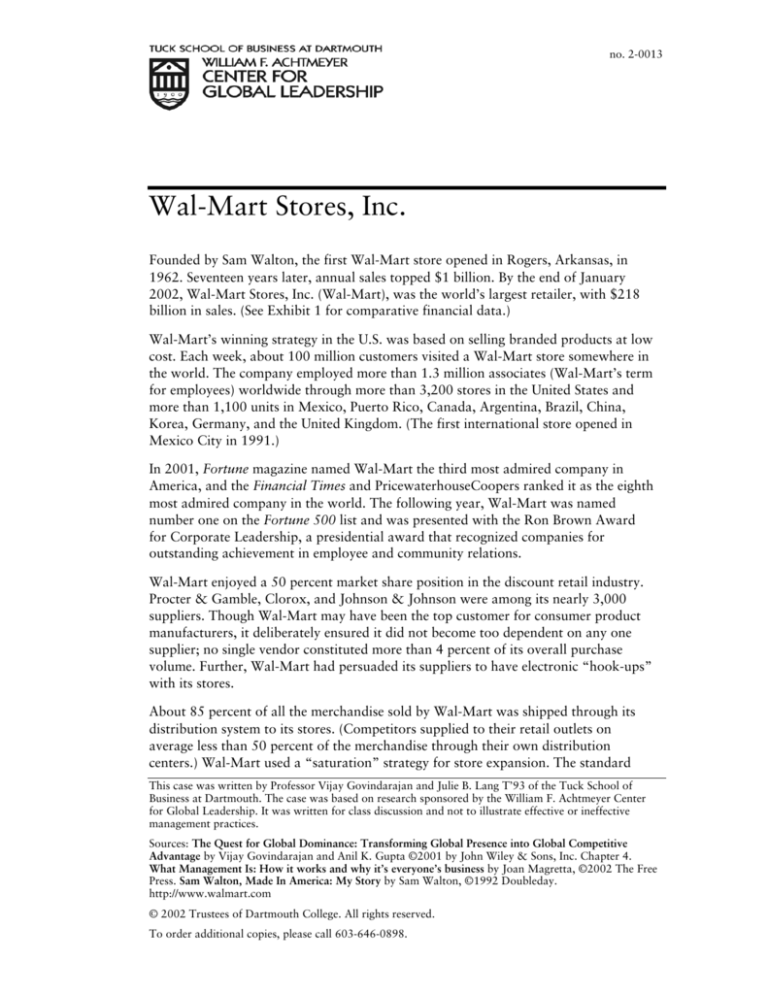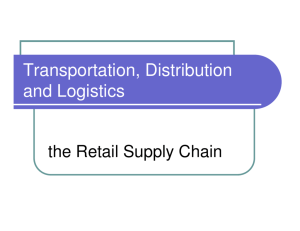
no. 2-0013
Wal-Mart Stores, Inc.
Founded by Sam Walton, the first Wal-Mart store opened in Rogers, Arkansas, in
1962. Seventeen years later, annual sales topped $1 billion. By the end of January
2002, Wal-Mart Stores, Inc. (Wal-Mart), was the world’s largest retailer, with $218
billion in sales. (See Exhibit 1 for comparative financial data.)
Wal-Mart’s winning strategy in the U.S. was based on selling branded products at low
cost. Each week, about 100 million customers visited a Wal-Mart store somewhere in
the world. The company employed more than 1.3 million associates (Wal-Mart’s term
for employees) worldwide through more than 3,200 stores in the United States and
more than 1,100 units in Mexico, Puerto Rico, Canada, Argentina, Brazil, China,
Korea, Germany, and the United Kingdom. (The first international store opened in
Mexico City in 1991.)
In 2001, Fortune magazine named Wal-Mart the third most admired company in
America, and the Financial Times and PricewaterhouseCoopers ranked it as the eighth
most admired company in the world. The following year, Wal-Mart was named
number one on the Fortune 500 list and was presented with the Ron Brown Award
for Corporate Leadership, a presidential award that recognized companies for
outstanding achievement in employee and community relations.
Wal-Mart enjoyed a 50 percent market share position in the discount retail industry.
Procter & Gamble, Clorox, and Johnson & Johnson were among its nearly 3,000
suppliers. Though Wal-Mart may have been the top customer for consumer product
manufacturers, it deliberately ensured it did not become too dependent on any one
supplier; no single vendor constituted more than 4 percent of its overall purchase
volume. Further, Wal-Mart had persuaded its suppliers to have electronic “hook-ups”
with its stores.
About 85 percent of all the merchandise sold by Wal-Mart was shipped through its
distribution system to its stores. (Competitors supplied to their retail outlets on
average less than 50 percent of the merchandise through their own distribution
centers.) Wal-Mart used a “saturation” strategy for store expansion. The standard
This case was written by Professor Vijay Govindarajan and Julie B. Lang T’93 of the Tuck School of
Business at Dartmouth. The case was based on research sponsored by the William F. Achtmeyer Center
for Global Leadership. It was written for class discussion and not to illustrate effective or ineffective
management practices.
Sources: The Quest for Global Dominance: Transforming Global Presence into Global Competitive
Advantage by Vijay Govindarajan and Anil K. Gupta ©2001 by John Wiley & Sons, Inc. Chapter 4.
What Management Is: How it works and why it’s everyone’s business by Joan Magretta, ©2002 The Free
Press. Sam Walton, Made In America: My Story by Sam Walton, ©1992 Doubleday.
http://www.walmart.com
© 2002 Trustees of Dartmouth College. All rights reserved.
To order additional copies, please call 603-646-0898.
Wal-Mart Stores, Inc.
no. 2-0013
was to be able to drive from a distribution center to a store within a day. A
distribution center was strategically placed so that it could eventually serve 150-200
Wal-Mart stores within a day. Stores were built as far away as possible but still
within a day’s drive of the distribution center; the area then was filled back (or
saturated back) to the distribution center. Each distribution center operated 24 hours
a day using laser-guided conveyer belts and cross-docking techniques that received
goods on one side while simultaneously filling orders on the other.
The company owned a fleet of more than 3,000 trucks and 12,000 trailers. (Most
competitors outsourced trucking.) Wal-Mart had implemented a satellite network
system that allowed information to be shared between the company’s wide network
of stores, distribution centers, and suppliers. The system consolidated orders for
goods, enabling the company to buy full truckload quantities without incurring the
inventory costs.
In its early years, Wal-Mart’s strategy was to build large discount stores in small rural
towns. By contrast, competitors such as Kmart focused on large towns with
populations greater than 50,000. Wal-Mart’s marketing strategy was to guarantee
“everyday low prices” as a way to pull in customers. Traditional discount retailers
relied on advertised “sales.”
Management Systems
Each store constituted an investment center and was evaluated on its profits relative
to its inventory investments. Store-level data on sales, expenses, and profit and loss
were collected, analyzed, and transmitted electronically on a real-time basis. The data
could be analyzed by region, district, store, department within a store, or even at the
level of an item within a department.
One of the significant costs for retailers was shoplifting, or pilferage. Wal-Mart
addressed this issue by instituting a policy that shared 50 percent of the savings from
decreases in a store’s pilferage among that store’s employees through store incentive
plans.
Early in Wal-Mart’s history, Sam Walton implemented a process requiring store
managers to fill out “Best Yesterday” ledgers. These relatively straightforward forms
tracked daily sales performance against the numbers from one year prior. Recalled
Walton, “We were really trying to become the very best operators—the most
professional managers—that we could.… I have always had the soul of an operator,
someone who wants to make things work well, then better, then the best they possibly
can.”1 His organization was really a “store within a store,” encouraging department
1
Joan Magretta, What Management Is: How It Works and Why It’s Everyone’s Business (The Free
Press, 2002),189.
Tuck School of Business at Dartmouth – William F. Achtmeyer Center for Global Leadership
2
Wal-Mart Stores, Inc.
no. 2-0013
managers to be accountable and giving them an incentive to be creative. Successful
experiments were recognized and applied to other stores. One example was the
“people greeter,” an associate who welcomed shoppers as they entered the store.
These greeters not only provided a personal service, their presence served to reduce
pilferage. The “10-Foot Attitude” was another customer service approach Walton
encouraged. When the founder visited his stores, he asked associates to make a
pledge, telling them, “I want you to promise that whenever you come within 10 feet
of a customer, you will look him in the eye, greet him, and ask him if you can help
him.”2
In return for employees’ loyalty and dedication, Walton began offering profit sharing
in 1971. “Every associate that had been with us for at least one year, and who
worked at least 1,000 hours a year, was eligible for it,” he explained. “Using a
formula based on profit growth, we contribute a percentage of every eligible
associate’s wages to his or her plan, which the associate can take when they leave the
company, either in cash or in Wal-Mart stock.”3 In 2001, Wal-Mart’s annual
company contribution totaled $486 million.
Wal-Mart also instituted several other policies and programs for its associates:
incentive bonuses, a discount stock purchase plan, promotion from within, pay raises
based on performance not seniority, and an open-door policy.
Discussion Questions
1. What is Wal-Mart’s strategy? What is the basis on which Wal-Mart builds its
competitive advantage?
2. How do Wal-Mart’s control systems help execute the firm’s strategy?
2
3
http://www.walmart.com
Sam Walton, Sam Walton, Made In America: My Story (Doubleday, 1992), 132.
Tuck School of Business at Dartmouth – William F. Achtmeyer Center for Global Leadership
3
Wal-Mart Stores, Inc.
no. 2-0013
Exhibit 1 Comparative Financial Data on Selected Companies
Five-Year Average: 1995-2000
Wal-Mart
Five-year return on equity (percentage)
19.9
Five-year sales growth (percentage)
15.4
Five-year net income growth (percentage)
18.1
Kmart
4.8
1.3
Neg
Sears Target
20.8
17.9
3.2
9.4
-5.7
32.4
Walgreen
18.3
15.3
19.3
Sales ($B)
191.3
2000 Data
37.0 40.9
36.9
As percentage of sales:
Cost of goods sold
Gross margin
Selling and administration
Operating income
Net Income
77
23
16.5
6.2
3.3
77
23
19.0
3.9
-0.7
66
34
23.3
11.0
3.3
69
31
22.2
9.3
3.4
72
28
21.3
6.9
3.7
7
20
4
-4
5
20
6
19
6
18
Inventory turnover
Return on equity (percentage)
Tuck School of Business at Dartmouth – William F. Achtmeyer Center for Global Leadership
21.2
4






